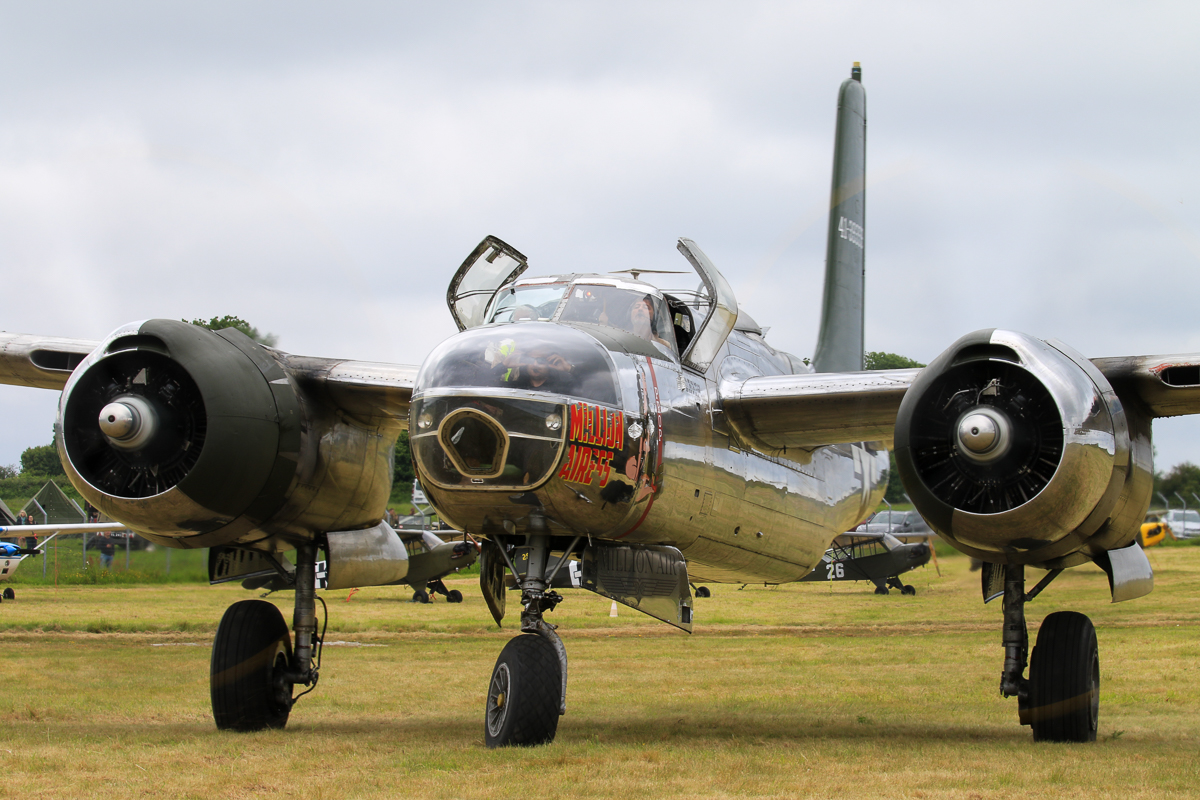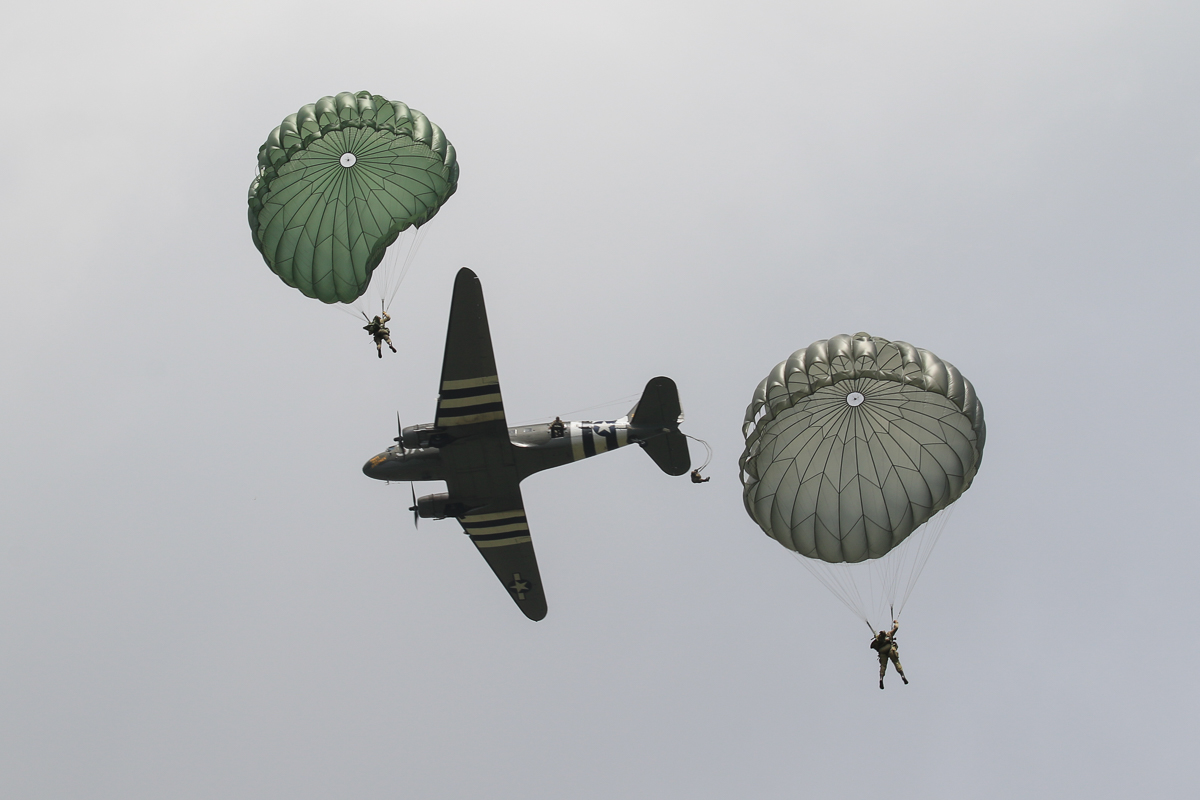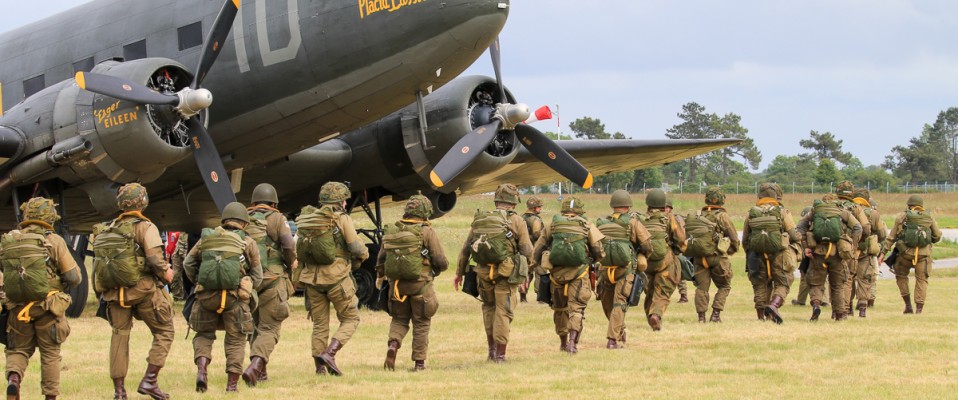D-Day 80 – Time Collects its Toll
Report and photos by Gabriele Rivera
August 7, 2024

Five years after our previous tour of UK airstrips and French beaches during the 75th anniversary of the D-Day, we’ve decided to return to the locations of the Allied landing for this year’s celebrations. On May 18th the American contingent of Douglas C-47 and DC-3 aircraft left Waterbury-Oxford airport in Oxford, Connecticut, and started to follow the original Blue Spruce route, whose intermediate stops are Presque Isle (Maine), Goose Bay (Canada), Narsaruaq (Greenland), Reykjavik (Iceland), Glasgow-Prestwick (Scotland), and finally North Weald (Essex, England). The transfer from USA to UK has taken five solid days, after which the aircraft have rejoined with a couple of UK-based old friends.
The so called 24LT (Legacy Tour) contingent consisted of five aircraft:
- C-47 “Placid Lassie” (N74589) – Tunison Foundation
- C-47 “Screaming Eagle” (N150D) – Hugo Mathys
- C-47 “That’s All, Brother” (N47TB) – Commemorative Air Force (CAF)
- C-53 “Spirit of Douglas” (N8336C) – privately owned
- DC-3 “Western Air” (NC33644) – Western Airlines Inc.


Unfortunately enough, the Screaming Eagle’s transatlantic flight has stopped in Greenland; once landed there, the crew has realized that the oil cooler was not running properly, and so the decision to cancel the remaining flight legs has been taken. They have also tried to transfer the crew to Switzerland, where their other asset, the DC-3 Swissair, is based, but an extensive low pressure area over the Alps has discouraged their crossing, missing the small windows of opportunity to reach the celebrations on time.
A sixth one, an U.S. Navy R4D “READY-4-DUTY” (151ZE), likewise contributed by the CAF, was one of the party, but a spiteful right engine, even though having flown only 250 hours circa, has forced her to remain at Oxford and, eventually, to return back to base in Texas.
As anticipated other two ships were waiting for the American ones to land in UK:
- C-47 “Drag ‘em Oot” (N473DC) – Aero Legends
- C-47 “Pegasus” (G-ANAF) – Aero Legends.

Just to quote, while strolling along Omaha beach, we’ve spotted “Princess Amalia” overflying, a Dutch-registered DC-3 born as C-47; this airplane felt the heat of the D-Day action, dropping paratroopers over Sainte-Mère-Eglise.
Other participants had been announced during the preparatory phase in April, but maintenance issues or missed thresholds in reaching the needed funding have prevented their participation. Quite understandably the challenges posed by the monumental task to fly 80-years old airplanes on the other side of the Atlantic and then bring them back home become every year more and more difficult, and this make us aware that the magnificent show we have had the opportunity to attend five years ago hardly will be again.

Also this year’s schedule has planned the Dakotas shuttling between UK and France, but this time we’ve decided to follow only the French-based activities. So, on June 4th, we’ve visited Cherbourg-Maupertus airport, which has hosted our beloved transports and, incidentally, also some of the USAF Hercules that have flown along the sandy beaches of Normandy, silent protagonists of the 1944’s landings. In those days the airport, used by the German Luftwaffe during the occupation of France, was seized by the U.S. Army three weeks after the landing and used for several months as a resupply and casualty evacuation airfield.


Together with the Dakotas, we have had also the lovely opportunity to enjoy the activities of two North American P-51D Mustangs, an Hawker Hurricane Mk. I (R4118, the last airworthy Battle of Britain surviving Hurricane!), a Supermarine Spitfire Mk. T.9 (ML295, 50 years before being converted in a two-seat configuration she served in the Royal Canadian Air Force, escorting bombers over France and then being based in Beny-sur-Mer in June 1944), a Beech D17S, the arrival of “Drag’em Oot” from the UK and, totally unexpected, a Douglas A-26C Invader, “Million Airess” (N26BP)! Parked on the sidelines, five L-Birds (three Piper J-3C-65 Cub, a Taylorcraft Auster Mk. 5, and a Cessna O-1 Bird Dog ) have silently witnessed the activities going on, knowing it was not yet their turn to take to the air. An interesting gathering of several L-Birds was based in a small airport near Caen; it was our plan to pay a visit to them on June 6th, but being their base inside the “red zone” it was impossible to reach them that day.

The afternoon spent in Cherbourg Maupertus has offered also the chance to take a few pictures of the paratroopers readying to board the planes for their next launch; while the events planned in UK a few days before had included photosessions with reenactors who recreated the mood that pervaded the British airports eighty years ago, few hours before the start of the massive operation, the operations on the French side of the Channel have partially missed this intention; among the paratroopers, most of them dressed and equipped with historically accurate uniforms and weapons, you could easily spot someone who, for several reason, was not observing the reenactment credo.
On the other hand we have had the opportunity to attend to a massive drop of paratroopers on a Landing Zone near the German artillery battery in Azeville; as five years ago, the paratroopers use round canopy parachutes, helping to visually recreate the images we’ve seen dozens of times on history books.


Unlike last time, this year we have not had the chance to take pictures of the beaches’ overflight during the official celebrations held on June 6th; not residing inside the red zone activated since the first hours in the morning, the strict security measures enforced to protect President Biden and all the other heads of state invited have rendered reaching the shore an impossible mission.
Thanks to the streaming broadcasted by the French television we know that a formation of C-47, followed by the Mustangs and the Hurricane, have been part of the aerial parade closing the celebrations, but during the days spent in Normandy we’ve been often offered the view of Hercules and other U.S. assets overflying beaches and towns.

While the aerial activities have not been so satisfying as five years ago, we must underline the exciting experience you can live visiting those historical sites during the massive celebrations held every five years. Owners of war machines of every model (Shermans and other tanks, Dodges, jeeps, half-tracks, motorcycles and so on) gather in camps hosted by the towns which have seen intense fighting eighty years ago. Visiting these camps it’s quite a time travel: groups of reenactors wearing historically accurate uniforms intent on maintaining weapons and engines, cooking, or showing how things worked during the Normandy campaign. But also the people strolling around often contribute to this mood, wearing civilian and military clothes inspired to what our grandparents used to wear during those years.


One thing can certainly be said about the museums scattered over the entire area of the landing; visiting them is obviously quite educational, but some offer the chance to experience how it was to fly in a Dakota at night, recreating the sounds, vibrations and the terrifying tension looming over the paratroopers seated on the two sides of the cabin.

As the title of this report recites, time is takings its toll; every year the number of veterans participating in the celebrations is shrinking, and also the machines which have been protagonists of the action of those days have growing problems in being part of them, but visiting Normandy in June is something that must be experienced at least once in lifetime, to view with one’s own eyes the locations where those heroes have lost their precious life and to pay tribute to those that have fallen for our freedom.

Omaha Beach
Gabriele was born in Turin, Italy, grew up in Sicily and now lives in Rome. His love for aviation goes back to the days when he was seven years old, he started to collect the ‘History of Aviation’ sold weekly at the nearby newsstand. With that, he realized that his goal was to become a military pilot. This dream met a harsh reality when, during the medical tests, a defect in his chromatic sense of sight was discovered.
His interest in photography arose a few years later, when he bought from a colleague his first single-lens reflex camera, a Pentax ME Super. Then everyday life took its toll; working as an IT analyst, studying for an MD in political science and starting a family left no time for enjoying his old interest for aviation. One day in 2008, he decided to revive the passion, starting again to take pictures of aircraft each time he has a chance. Now, using Canon gear, he is striving to become a photojournalist.
Gabriele can be reached at: [email protected]

